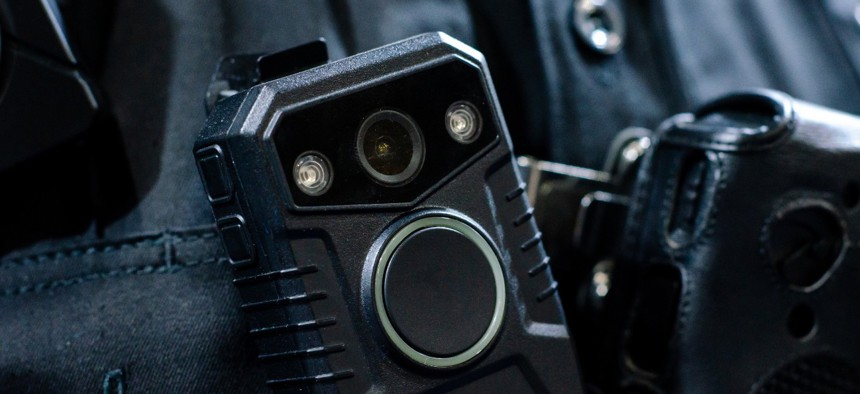
Body worn cameras should be used for “law enforcement interaction with the public in response to emergency calls, pre-planned arrests, or during execution of a search or seizure warrant or order,” the department stated in a press release. artas / iStock / Getty Images Plus
DHS Releases its First Body Worn Camera Policy
This follows requirements from an executive order President Biden issued last year on police accountability.
The Homeland Security Department released on Tuesday its first-ever policy on body worn cameras, which will apply across the department’s 80,000 law enforcement officers.
The new policy comes in accordance with an executive order President Biden issued last May to increase accountability in policing on the two-year anniversary of George Floyd’s murder by a police officer and subsequent protests for racial justice. The law enforcement response to those protests was heavily criticized and scrutinized. Within 180 days, DHS’ agencies and offices have to issue or update their own policies to meet or surpass the requirements in the department-wide policy.
Body worn cameras should be used for “law enforcement interaction with the public in response to emergency calls, pre-planned arrests, or during execution of a search or seizure warrant or order,” the department stated in a press release. “Among other restrictions, [it] will not be used for the sole purpose of recording individuals engaged in First Amendment activity.”
This was crafted based on pilot projects, testing and phased rollouts over the past two years: Customs and Border Protection has already issued 7,000 body-worn cameras to its workforce for an “incident-driven video recording system program;” Immigration and Customs Enforcement ran a pilot program with a select group of special agents; and the Secret Service already issued its own policy to comply with the executive order.
DHS’s Office of Strategy, Policy and Plans will be developing standard metrics to track each agency’s program. Also, agencies have to make sure that their officers who use body worn cameras or work with body worn data have the required training, the policy stated.
The heads of federal law enforcement agencies must issue policies that match or exceed the standards in the Justice Department's policy issued in June 2021, the executive order said.
“Although this policy establishes requirements for the use of [body worn cameras], not all DHS law enforcement officers will immediately be issued cameras,” DHS stated. “Some DHS agencies and offices already have deployed [cameras] to its officers and agents; others will begin to employ cameras as funding becomes available.” Department officials are working to secure funding, so they can fully implement the policy.
Larry Cosme, president of the Federal Law Enforcement Officers Association, reiterated in a statement his association’s support for body worn cameras because they bolster trust and transparency between law enforcement officers and members of the public.
“At the same time, when short snippets of an encounter are released without context it can undermine the law enforcement mission and erode trust,” Cosme said. “As DHS components issue and update their policies, we will be looking to ensure offices maintain officer privacy and properly regulate the public disclosure of footage.” Additionally, he said his association will be working with members of Congress to make sure that DHS agencies have the funding they need.







